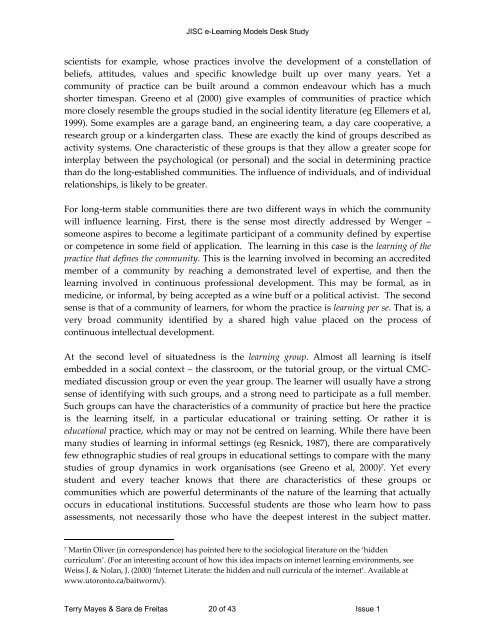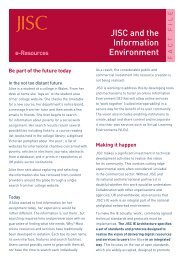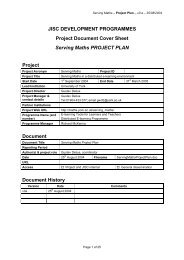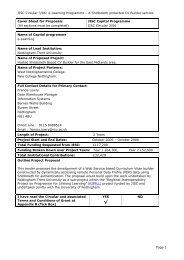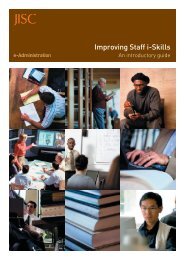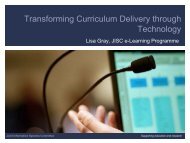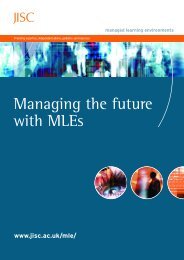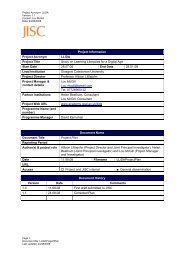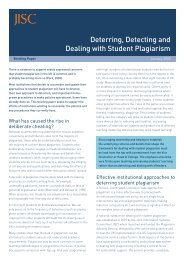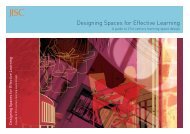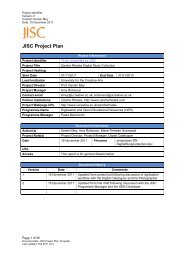Review of e-learning theories, frameworks and models - Jisc
Review of e-learning theories, frameworks and models - Jisc
Review of e-learning theories, frameworks and models - Jisc
You also want an ePaper? Increase the reach of your titles
YUMPU automatically turns print PDFs into web optimized ePapers that Google loves.
JISC e-Learning Models Desk Study<br />
scientists for example, whose practices involve the development <strong>of</strong> a constellation <strong>of</strong><br />
beliefs, attitudes, values <strong>and</strong> specific knowledge built up over many years. Yet a<br />
community <strong>of</strong> practice can be built around a common endeavour which has a much<br />
shorter timespan. Greeno et al (2000) give examples <strong>of</strong> communities <strong>of</strong> practice which<br />
more closely resemble the groups studied in the social identity literature (eg Ellemers et al,<br />
1999). Some examples are a garage b<strong>and</strong>, an engineering team, a day care cooperative, a<br />
research group or a kindergarten class. These are exactly the kind <strong>of</strong> groups described as<br />
activity systems. One characteristic <strong>of</strong> these groups is that they allow a greater scope for<br />
interplay between the psychological (or personal) <strong>and</strong> the social in determining practice<br />
than do the long-established communities. The influence <strong>of</strong> individuals, <strong>and</strong> <strong>of</strong> individual<br />
relationships, is likely to be greater.<br />
For long-term stable communities there are two different ways in which the community<br />
will influence <strong>learning</strong>. First, there is the sense most directly addressed by Wenger –<br />
someone aspires to become a legitimate participant <strong>of</strong> a community defined by expertise<br />
or competence in some field <strong>of</strong> application. The <strong>learning</strong> in this case is the <strong>learning</strong> <strong>of</strong> the<br />
practice that defines the community. This is the <strong>learning</strong> involved in becoming an accredited<br />
member <strong>of</strong> a community by reaching a demonstrated level <strong>of</strong> expertise, <strong>and</strong> then the<br />
<strong>learning</strong> involved in continuous pr<strong>of</strong>essional development. This may be formal, as in<br />
medicine, or informal, by being accepted as a wine buff or a political activist. The second<br />
sense is that <strong>of</strong> a community <strong>of</strong> learners, for whom the practice is <strong>learning</strong> per se. That is, a<br />
very broad community identified by a shared high value placed on the process <strong>of</strong><br />
continuous intellectual development.<br />
At the second level <strong>of</strong> situatedness is the <strong>learning</strong> group. Almost all <strong>learning</strong> is itself<br />
embedded in a social context – the classroom, or the tutorial group, or the virtual CMCmediated<br />
discussion group or even the year group. The learner will usually have a strong<br />
sense <strong>of</strong> identifying with such groups, <strong>and</strong> a strong need to participate as a full member.<br />
Such groups can have the characteristics <strong>of</strong> a community <strong>of</strong> practice but here the practice<br />
is the <strong>learning</strong> itself, in a particular educational or training setting. Or rather it is<br />
educational practice, which may or may not be centred on <strong>learning</strong>. While there have been<br />
many studies <strong>of</strong> <strong>learning</strong> in informal settings (eg Resnick, 1987), there are comparatively<br />
few ethnographic studies <strong>of</strong> real groups in educational settings to compare with the many<br />
studies <strong>of</strong> group dynamics in work organisations (see Greeno et al, 2000) 7 . Yet every<br />
student <strong>and</strong> every teacher knows that there are characteristics <strong>of</strong> these groups or<br />
communities which are powerful determinants <strong>of</strong> the nature <strong>of</strong> the <strong>learning</strong> that actually<br />
occurs in educational institutions. Successful students are those who learn how to pass<br />
assessments, not necessarily those who have the deepest interest in the subject matter.<br />
7 Martin Oliver (in correspondence) has pointed here to the sociological literature on the ‘hidden<br />
curriculum’. (For an interesting account <strong>of</strong> how this idea impacts on internet <strong>learning</strong> environments, see<br />
Weiss J. & Nolan, J. (2000) ‘Internet Literate: the hidden <strong>and</strong> null curricula <strong>of</strong> the internet’. Available at<br />
www.utoronto.ca/baitworm/).<br />
Terry Mayes & Sara de Freitas 20 <strong>of</strong> 43 Issue 1


